Win CENS ProFlex DX5 earplugs worth £1,149 – enter here
Grouse shooting on Wemmergill moor
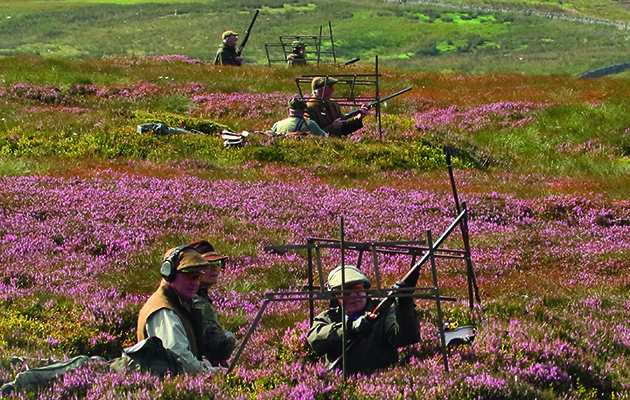
Driving across the Yorkshire Dales towards County Durham there’s not a soul to be seen, just the odd sheep and acres and acres of heather coming into bloom. It is a beautiful, stark landscape. To the uninitiated it’s bleak and lonely but keep climbing and driving away from any sign of civilisation, and then turn into Stackholme Farm. Welcome to Wemmergill Moor, one of the world’s premier grouse moors. The atmosphere changes immediately on arrival at the farm, the heart of Wemmergill on a shoot day. The place hums with activity.
The first thing I notice is a row of green, clean pick-ups, all with consecutive number plates, lined up waiting. Keepers dressed smartly in their tweeds organise the beaters and there are dogs everywhere. The air is buzzing with activity, a sense of purpose and anticipation for some of the most thrilling shooting anywhere.
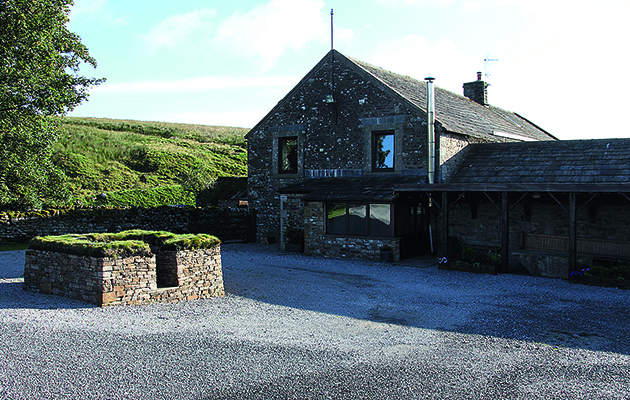
This demonstration butt outside the farm is used for the morning safety briefing
Safety first even for top guns
Leaving the keepers and their small army behind, I head back to the large converted barn with a grouse butt situated right in front of it for demonstration purposes. I am greeted by an air of tranquility and comfort and our hosts for the day, Michael and Sally Cannon, owners of Wemmergill. The Cannons bought Wemmergill, their third grouse moor, in 2006, having been tenants for a number of years. They have spent the ensuing years improving, conserving and rescuing it. In doing so they have re-established it as one of the world’s premier driven grouse moors and endowed this sporting paradise with everything it needs to continue delivering the goods for generations to come.
Today the weather is perfect for shooting: dry and bright (but not too bright) with a good wind and not a midge in sight. The first thing Mr Cannon does after everyone has been introduced and had a cup of coffee is take us all outside to gather around the grouse butt. He then runs through the safety briefing. “I do this for every shoot regardless of how experienced the guns are. It is vital to stress the safety aspect as the beaters and flankers, as well as other guns can all be vulnerable,” he says. Each grouse butt has a pair of frames left in them and each loader will erect these on either side at the start of every drive. This means the guns cannot swing through and endanger their neighbour, or the flanker. At Wemmergill you are asked to always stand in the front of the butt even if shooting behind, again for safety reasons. Today we are not to shoot black game as numbers are being protected, as is the case on most moorland.
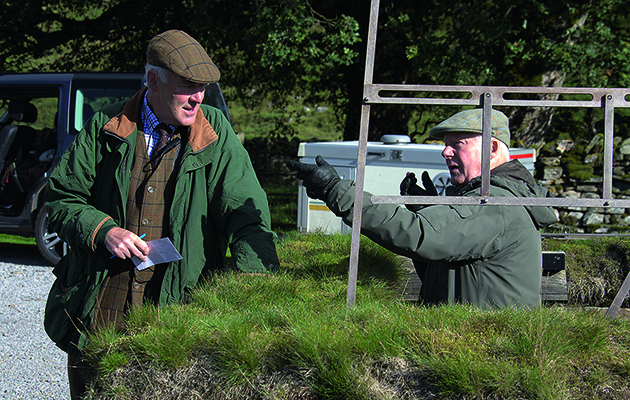
The morning safety briefing conducted by the owner
A kick in the teeth from Mother Nature
The guns here move up two every drive and they always number from the bottom of the hill upwards. The 2015 season was generally poor due to the dire rearing conditions in the spring. The weather was cold and wet with snow as late as early June, so many of the chicks did not survive. Disease has also been a problem, making the birds less resistant to the inclement conditions. Because of this, many days were cancelled, with some moors not shooting at all. Normally at Wemmergill they shoot 45 days but last season it was cut back to 17 and those days were shortened, with no shooting behind. Usually on a drive the birds will be driven towards the butts initially, the keeper will then blow his horn to indicate it is unsafe to shoot in front because of the proximity of the beaters, and all the guns will turn in their butts to carry on shooting.
“That’s grouse shooting for you,” says headkeeper John Pinkney. “We have had some very good years so you forget how bad it can be. This year has been a reality check but there’s nothing you can do about it. Nature kicks you in the teeth sometimes.”
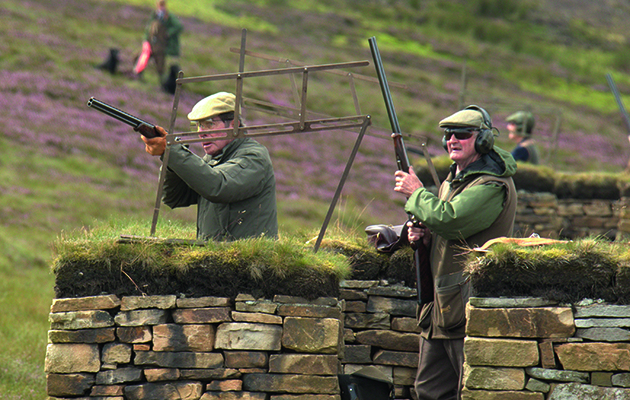
Action from this day during the 2015 season, which was adversely affected by terrible weather in May and June
Massive moorland investment
The whole of Wemmergill covers a vast 18,000 acres, which is more than 28 square miles, and crosses the county boundary from Cumbria into County Durham. Today we are shooting on the north side of the moor. The roads across the moor have all been repaired and updated. No expense has been spared to make the moor more accessible for the whole team who work so hard to improve the habitat on this piece of moorland. After all, it’s not just the red grouse that benefit from a diverse piece of heather moorland – a whole range of waders, including redshank, golden plover and curlew also enjoy exactly the same conditions as the grouse, and to maintain a moor like this, access is imperative.
Once in the butts for the first drive, the end gun acknowledges the flanker so both are aware of each other’s position. It might seem like a minor detail but this sort of communication is vital to the safety and success of any day on the moor.
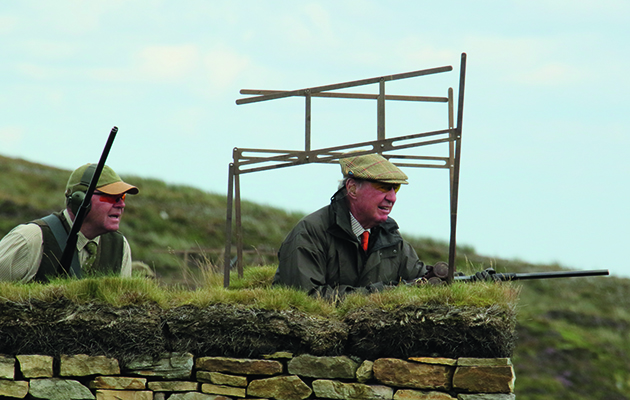
Bob Arthur scans the horizons for grouse
The loaders set the brackets up, load the guns and we wait. Wemmergill runs two teams of beaters to reduce the amount of waiting time. One team works on the current drive while the other starts walking in the next one. The going is hard for these teams on the springy heather where every step presents a challenge, and they walk miles during the day. The flankers do a vital job on each drive ensuring the grouse stay within the channel of the line of butts. These flankers are often older men (not to do them a disservice!) who have spent years in the beating team.
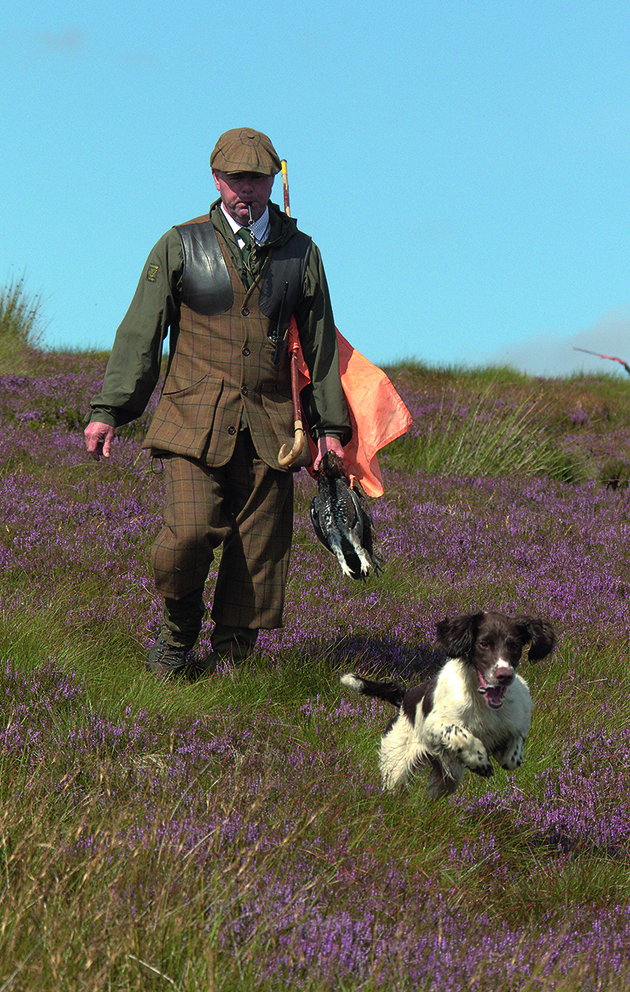
A day on the moor should knock some energy out of that springer
Like turbocharged pigeons
The secret to successful grouse shooting is to keep still in the butt. These birds are wild and as soon as they spot movement will veer off sharply. Guns should also always wear a hat and shooting glasses for safety.
We don’t have to wait long before the first birds appear over the hill. Silent and fast, many flying low and hugging the hillside. They have to be spotted early and quick reactions are essential. The grouse appear from all directions, so a successful partnership is needed between gun and loader, who will also act as a spotter.
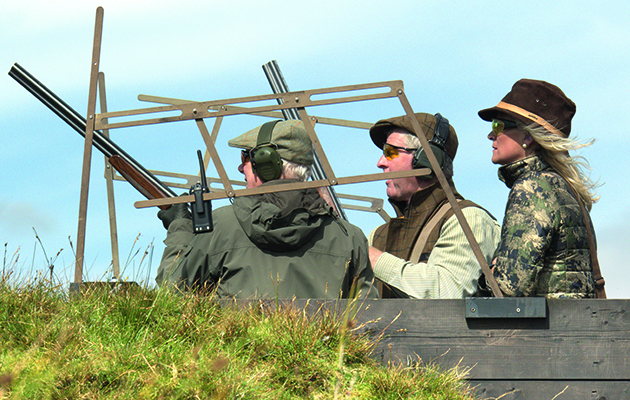
Michael Cannon in action with long-time loader make a good team with the author watching on
Mr Cannon and his loader Ian have been together for more than 10 years and it shows. “One o’clock,” says Ian quietly and Mr Cannon is on the bird instantly. He uses a pair of Perazzi 12 bores with deadly effect, and the quick gun handling between the pair is a joy to witness. After the initial flurry passes, Ian notes the position of all the shot birds on his marker card while Mr Cannon clicks the number of kills – all to help the picking-up team at the end of the drive.
The second covey of grouse is on us in minutes. The numbers might be low compared to the better years but to the uninitiated like me there seems to be plenty of them. They come from all directions presenting shooting at lots of different angles: crossers, overhead and going away. There is very little time and reactions have to be lightning quick. It is tremendously exciting and it’s obvious why people get hooked on this unique form of shooting. There’s nothing quite like it – a bit like pigeon shooting maybe, but on speed.
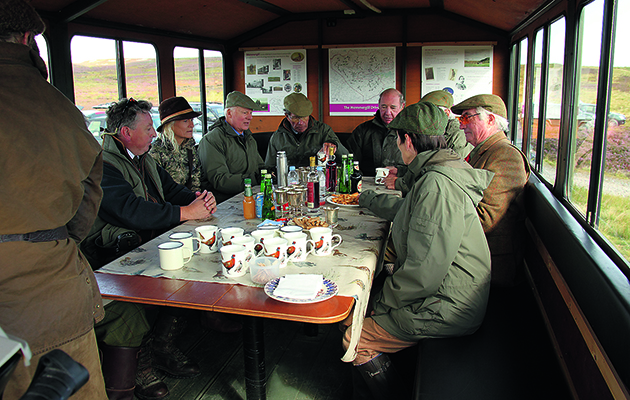
Elevenses in the gunbus
From America with a passion for grouse
All too quickly the swarms of beaters appear over the hill heading towards us, and this battalion are strong, young and lean looking. Being August, many of them are students and schoolchildren who can join the team once they are 13 years old. This is definitely a young persons’ game as fitness levels must be high with lots of hill walking over rough terrain.
At the sound of the horn to signal the end of the drive, the pickers-up swoop. Many of them work large teams of dogs and the keeper’s wife has 11 on the go, all working together perfectly. The guns pick-up birds nearby and leave them on the top of the butt to be collected later. It is fascinating to see the dogs working so effectively. Large numbers are needed as it can be difficult to find fallen birds in the heather, and the area to be covered is large. A dead grouse can fall a long way from the point at which it was shot, due to its own speed and the lie of the land.
Before the next drive, hot soup and freshly cooked sausages are served in the gunbus. I take the chance to chat to the other guns, who are all visiting from America. They visit the UK for grouse shooting every season and are spending 10 days shooting grouse – three more days on Wemmergill, and the rest on other nearby moors.
“I would rather shoot one wild grouse than a dozen pheasants,” ex-Wall Street stalwart Win Tuttle tells me. “Grouse shooting is thrilling and there’s nowhere else in the world you can do it.”

A Galazan gun from America graces the moor
Looking for a legacy
At the next drive I have some time to talk to Mr Cannon before it begins. Since buying Wemmergill he has planted more than 200,000 trees, many of them rowan which the black game love, and willow. Planting is still ongoing. The moor team work closely with Natural England, ornithologists and ecologists. The owner says: “We have re-profiled gullies that were eroded to create a fresher, purer water supply. And we have filled in miles and miles of grips, planted thousands of trees and improved the roads to make access to the moor possible. Bits of it could not be reached at all when I first bought it. Butts have been moved and buildings improved.”
One of the first things Mr Cannon did after buying the moor was to re-roof all the houses. He works closely with the tenant farmers. “We have a controlled heather burning policy. Newly sprouting heather offers 35 percent protein for the grouse and also holds the insects well. We need to keep the more mature plants for cover as well, so we burn off small areas of the moor at a time while keeping older plants in the same area.”
The moor owners are also improving large areas around the butts to enable easier access by laying mesh 1.8m-2m wide. This means an Argocat can travel on the moor and the vegetation can grow through the mesh. This experiment in conjunction with Natural England will run for five years. The relationship between moor owner and Natural England has not always been entirely cordial, but over the years it has greatly improved. Indeed, one would think Natural England would be delighted to have an owner who is prepared to spend so much money improving the moor and is so dedicated to its conservation and care. “My legacy is to leave the moor in good heart and to maintain the sustainable harvest,” says Mr Cannon.
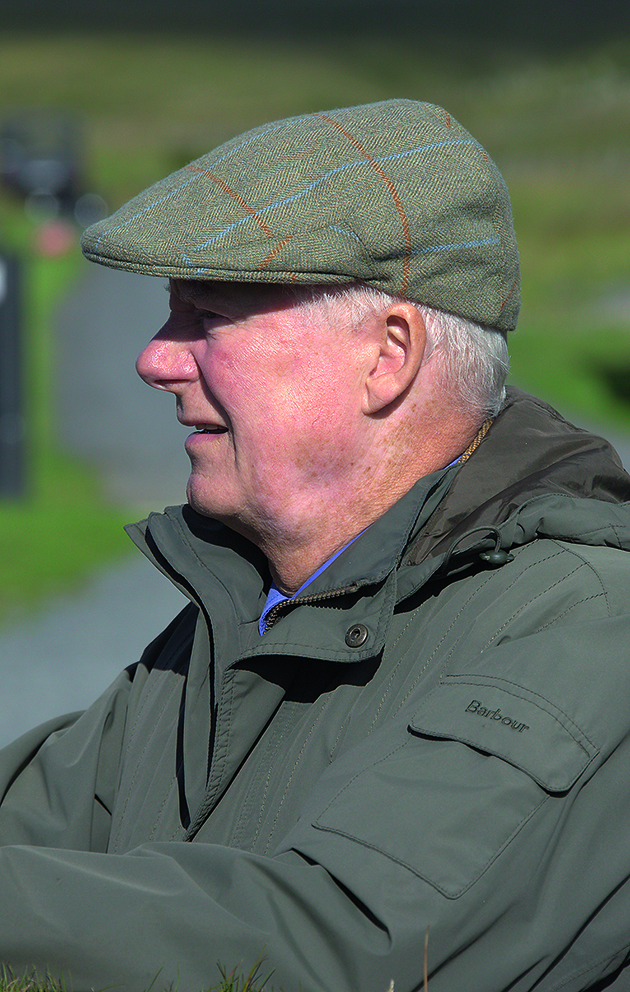
Michael Cannon bought Wemmergill outright eight years ago having previously held the sporting rights
From YTS to headkeeper
And then the drive begins. The window for spotting the birds is even smaller here so we are all on full alert. There follows some impressive shooting from all the guns, with the host hitting many rights and lefts – a pleasure to watch.
We return to the farm for an excellent lunch where I get the chance to speak to the other guns, all of whom are equally enthusiastic about grouse shooting. John Mullin tells me: “The birds are unique here – wild and in such large quantities – it’s just fabulous. There is no better shooting anywhere in the world.”
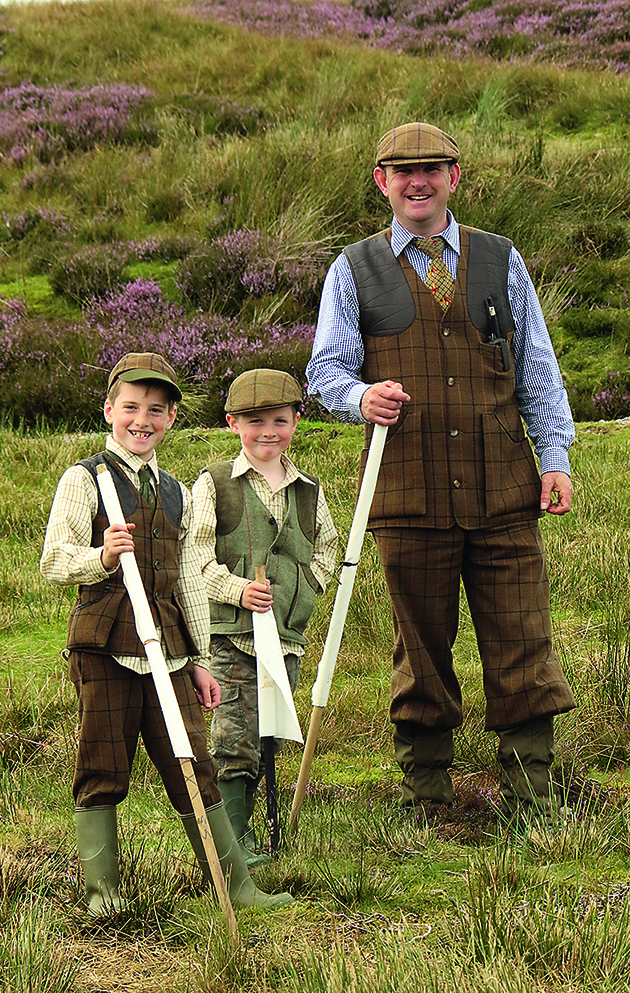
Headkeeper John Pinkney started as a YTS trainee
On a typical day of driven grouse shooting here, more than 80 people are involved, including the guns, 60 beaters, the loaders and pickers-up, as well as seven full-time keepers. Mr Cannon doubled the number of keepers when he took the moor on and appointed John Pinkney headkeeper 12 years ago. John started out as a Youth Training Scheme boy, working his way up to beatkeeper on the north side before being offered the headkeeper’s job.
The final drive of the day is the Allotments, on the north-eastern-most tip of the moor. It feels like we are on top of the world and can see for miles. “You can almost smell the honey,” says Mr Cannon as we wait in the butt surrounded by heather. The skylarks sing and snipe fly overhead followed by some golden plover. Then the grouse come. Where else could you possibly want to be on a perfect day like this?
Related Articles
Get the latest news delivered direct to your door
Subscribe to Shooting Times & Country
Discover the ultimate companion for field sports enthusiasts with Shooting Times & Country Magazine, the UK’s leading weekly publication that has been at the forefront of shooting culture since 1882. Subscribers gain access to expert tips, comprehensive gear reviews, seasonal advice and a vibrant community of like-minded shooters.
Save on shop price when you subscribe with weekly issues featuring in-depth articles on gundog training, exclusive member offers and access to the digital back issue library. A Shooting Times & Country subscription is more than a magazine, don’t just read about the countryside; immerse yourself in its most authoritative and engaging publication.







